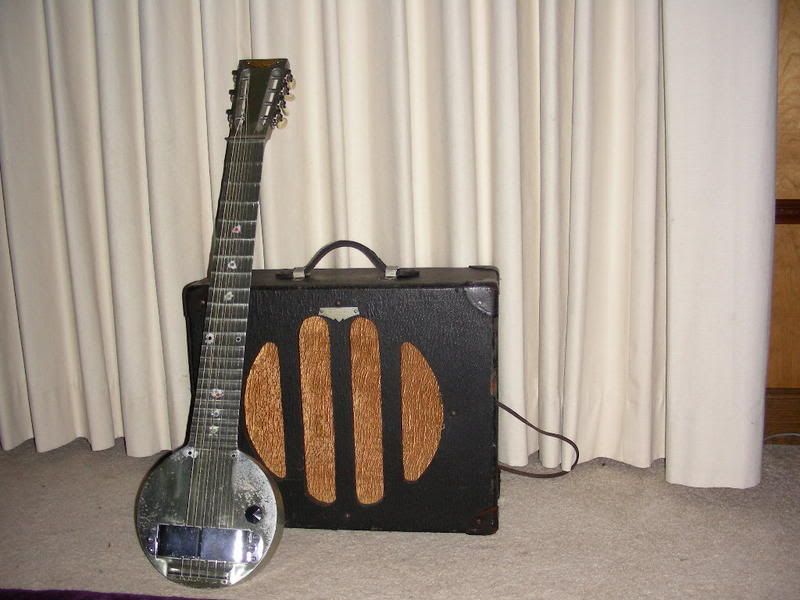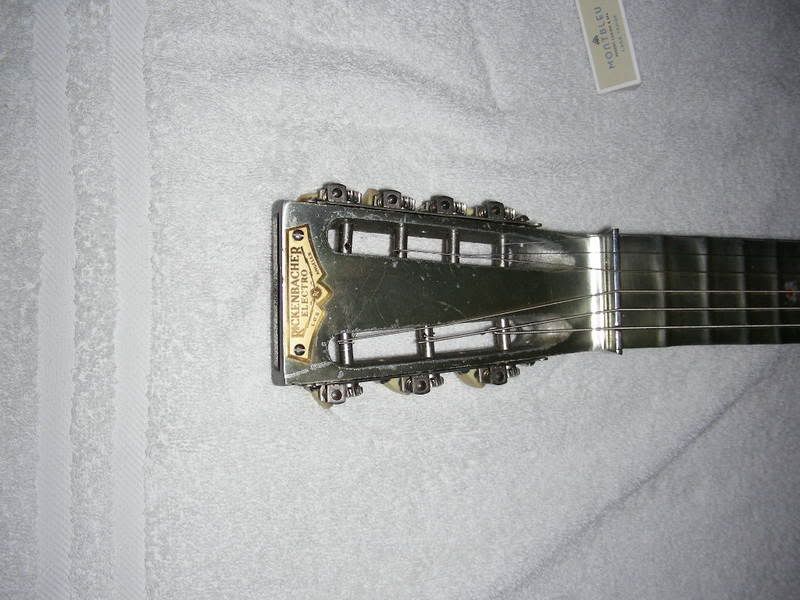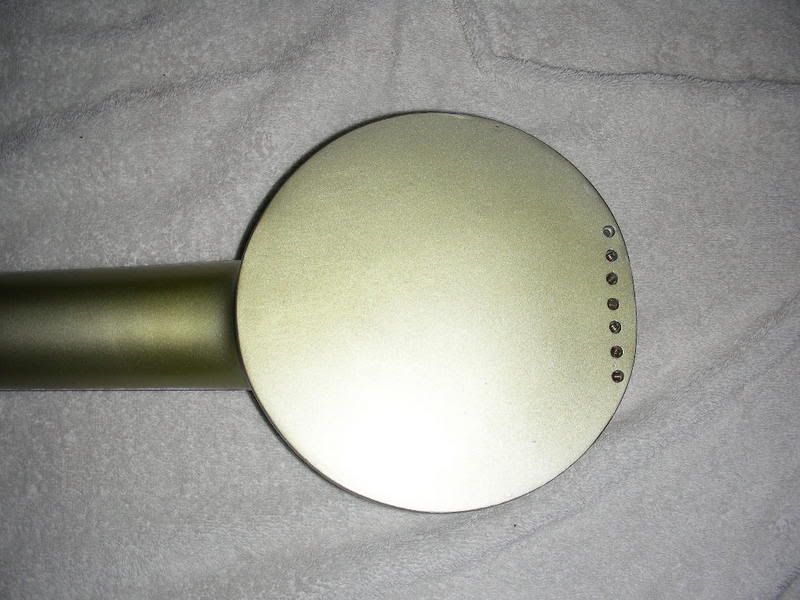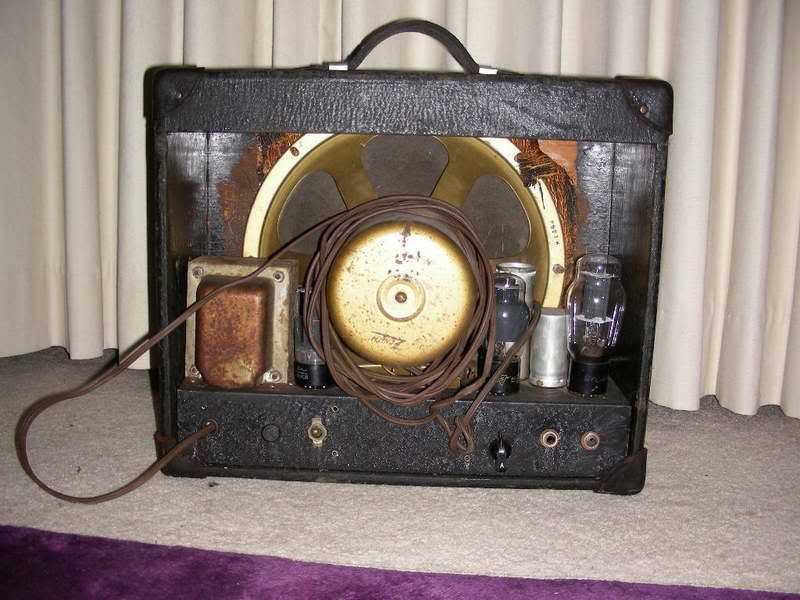Page 1 of 1
A-22 Frypan and amp ... wow!
Posted: 11 Dec 2007 6:50 pm
by Andy Volk
wow for coolness ... wow for historical significance ... wow for price
http://www.retrofret.com/products.asp?P ... 2512112007
Posted: 11 Dec 2007 8:25 pm
by Gary Lynch
We should be thankful that lap steels are considered obsolete in the guitar collecting world. Otherwise an item like this would be priced like a 1950's Fender Stratocaster up in the $20K - $30K range.
Vintage lap steels are the last great bargin.
Posted: 11 Dec 2007 8:58 pm
by Tom Pettingill
Sweet

Posted: 11 Dec 2007 10:14 pm
by Harry Sheppard
Ric prices seem to be a little soft at the moment. THE black prewar A25 Frypan pictured in the Smith Rickenbacher book just sold on Ebay for $1999 today. A nice post war A25 sold last week for $1325 with the original case and a beautiful early 1935 B7 just sold with a $1500 But-It-Now a couple of days ago. There has been a 7 string prewar Frypan listed for $3000 on gbase for quite a while now and Gruhn has an A22 frypan with original metal amp for a "reduced" price of $3900 (down from $5500 a few months ago). Elderly has had their prewar A22 frypan at $3500 for months.
That New York shop is usually more than double the market value and they have had this guitar for a long time (and will probably keep it a while longer at that price)...
Posted: 11 Dec 2007 10:51 pm
by Bill Creller
Looks like my 7 string pre-war is worth a few bucks

Not that I would sell it at this point though.
The A22 for sale looks like it was rarely played. There is no real way to date it either. The seller is guessing, or who-ever told him the year is guessing. Also,by now, most people know the serial numbers don't mean jack.
That one looks like an ideal museum piece.
Posted: 12 Dec 2007 3:24 am
by Andy Volk
True about the frypan market coming down a bit while poorer quality K&F lap steels have been heading up. It's that Fender mojo, I suppose. I remember how proud Ralph Kolsiana was of his frypan - the 4th ever made - that he had refinished using bronze lacquer from the automotive supply store. Bet the collector types would have a fit over that one! Except for their inherent tuning issues the frypan design has such a timeless and perfect marriage of form and function, not to mention the tone of that pickup. Retrofret's prices are quite high but I give them high-marlks for presentation. It's only a matter of time before vintage lap steel prices climb significiantly, I think. If only Leo Fender could see what a '53 Tele goes for today.
Posted: 12 Dec 2007 4:16 am
by basilh
I've never before seen the suggestion that it could be used as a regular electric SPANISH guitar and the strings FRETTED.
Did ANYONE ever play one that way ?
A-22 was marketed and usually used as a Hawaiian guitar, the neck is round and with a different set-up this instrument could also have been played Spanish style - something designer George Beauchamp alludes to in the patent application.
Posted: 12 Dec 2007 4:54 am
by Mark Switzer
The set-up would be very different indeed, I think, for that to work. I`d tell you what I paid for my set like that, but you all would hate me.
As the owner of two Fripans and one amp exactly like that one,I guess I should be happy to see this but I kind of hope we don`t get like some of my Bluegrass buddies whose Martins and Gibsons are almost too pricey to use on a gig.
Posted: 12 Dec 2007 8:24 am
by Andy Volk
I'm willing to be proven wrong but I think they're misinformed. I don't believe anyone EVER doubled on lap steel as standard guitar unless it were an emergency - and that goes for the Kona guitars too. It's just too impractical. The frypan was designed as a Hawaiian steel guitar and not a switch-hitter's instrument.
Tuning issues?
Posted: 12 Dec 2007 2:33 pm
by Todd Weger
Andy Volk wrote:Except for their inherent tuning issues the frypan design has such a timeless and perfect marriage of form and function, not to mention the tone of that pickup.
I have two custom made cast aluminum frypans that used an A25 as the basic template, and I've never had any tuning issues with either of them. I guess I should say though that if I take it from a Florida air-conditioned room to the lanai outside in the middle of summer here, then there will be some instability for a while, although any of my instruments will do that, too.
For the long haul though, I've been able to play them for quite some time before I need to retune.
And yes, those pickups sound so incredible (mine have Ricky horseshoes that were taken out of a 1949 console).
Posted: 12 Dec 2007 6:32 pm
by Gary Lynch
Todd,
If your custom pans have a solid cast neck, that makes a difference. I believe the Ric necks were hollow.

Correct me if I am wrong.

My custom frypan has a solid neck at it too stays in tune nicely. That extra beef may be the reason it seems stable?

Also, the type alloy used in the casting makes a different according to authorities of advanced knowledge.

Posted: 12 Dec 2007 7:48 pm
by Bill Creller
The frypans, at least the hollow neck pre-war models, and also bakelites, will always be touchy about temp. Jerry Byrd mentioned the problem with a bakelite in TV studio lighting, which must have been warm. There doesn't seem to be a problem around the house, just outdoors in sun versus shade etc.
I can tolerate the tuning problems OK in order to play Ricks

All this stuff
Posted: 12 Dec 2007 8:13 pm
by Richard Shatz
Retrofret sends me their stuff all time.
Everything is beautifully documented and photographed and also sometimes contains some conjecture.
The impression I get is they are only middle men (buy low and sell high) with a great deal of research. That's just capitalism and I don't see anything wrong with that. In fact I love the whole way of internet marketing of anything of value to a very small market. As always, it's caviat emptor, just as it is when you buy a used/vintage instrument in a "vintage guitar store".
If you want a fine vintage instrument, you really should know every original nut, screw and bolt.
Nevertheless, I have bought some of my most valued lap steels on Ebay. Yes, I've been screwed a few times, but that's when I haven't payed enough attention to detail.
I have to say that irregardless of how ridiculous the price might seem for this set; it really doesn't matter. The market will set the price. It's all supply and demand. My guess is that if I called them tomorrow, I think I could buy the set for around $4000-4500,o.k., maybe $5500, which I think is a fair price for what appears to be a great set, but not museum quality. I would really like to see that set sold for the asking price. If that happens I might just offer to sell my 7-string, s/n A28 with the same matching amp in better "museum quality" condition. Here are some pics.






I guess I'm just showing off, but I couldn't resist.
Posted: 13 Dec 2007 3:29 am
by Andy Volk
Let's not forget the appeal of a spanking new, shinning, more affordable modern frypan with fabulous tone and built-in mojo right out of the box ... the Aiello Dustpan







